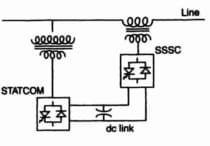 |
| HVDC/HVE |
1. Control of power in DC link is necessary because_________.
(a) current order setting needs to be done
(b) power can be reversed
(c) current sensitive to voltage changes and may damage the converters
(d) all of the above
2. With increase in delay angle, a______.
(a) p.f. is reduced
(b) DC voltage decreases
(c) both (a) and (b)
(d) kVAR requirement decreases
3. For inversion or inverter operation_______.
(a) a < 90°
(b) a > 90°
(c) 90° < a < 180°
(d) 180° < a < 270°
4. Extinction angle g is optimised so that_______.
(a) DC current is kept minimum
(b) kVAR requirement is minimum
(c) DC output voltage is minimum
(d) all of the above
5. For stable operation of DC systems_________.
(a) CC and CEA control is adopted
(b) a control, CC and CEA is adopted
(c) only CEA control is adopted
(d) only CC control is adopted
6. Characteristic of a converter is the relation between________.
(a) AC voltage and Id
(b) DC output voltage and Id
(c) DC power and Id
(d) a and Id
7. The common control done in converters is________.
(a) rectifier as both voltage and current controller
(b) inverter as both voltage and current controller
(c) inverter as current controller
(d) rectifier as voltage controller and inverter as current controller
8. VDCOL controlling is done and is necessary when______.
(a) low voltage due to faults
(b) to regulate DC current depending on DC voltage due to fault on AC side
(c) to regulate DC current when DC voltage dips
(d) to regulate AC current under faults
9. Power reversal in DC link is done_______.
(a) operating rectifier (a) close to 180° and inverter g close to zero
(b) operating both a and g near 90°
(c) operating an at 90° and g close to zero
(d) operating g close to 90° and a near zero
10. In case of IPC cosine control, DC output voltage is proportional to_________.
(a) control voltage
(b) DC current
(c) cos–1 of phase angle on AC side
(d) overlap angle m
11. The main drawback of CEA control is________.
(a) it cannot offer stable operation in weak AC links
(b) more reactive kVAR are needed
(c) control is uneconomical
(d) generates harmonics
12. Firing angle control in modern HV converters is_______.
(a) IFC
(b) EPC
(c) IPC
(d) both (a) and (b)
13. In HVDC link with CC control________.
(a) power loss is more
(b) short circuit current is limited
(c) both (a) and (b)
(d) none of the above
14. Commutation failure usually occurs in_________.
(a) rectifiers
(b) inverters
(c) both inverters and rectifiers
(d) controllers
15. A rectifier station is set at a current level of 900 A and inverter station at 800 A. The current margin is________.
(a) 100 A
(b) 50 A
(c) 200 A
(d) – 100 A
16. In order to bring the voltage of operation to the normal voltage level as the power varies, control done is_____.
(a) a control
(b) transformer tap changing
(c) g control
(d) both a and g control
17. Converter transformer act as a source of generation of harmonics because of _________
(a) magnetostiction
(b) nonlinear nature of B–H curve of iron core
(c) magnetising current
(d) none of the above
18. In a 12-pulse converter, the two 6-pulse converter groups are fed from transformers connected as_______.
(a) Y–Y and Y–D
(b) Y–Y and Y–Y
(c) D/D and D–Y
(d) Y–Y and D–D
19. In a 12-pulse bridge, if one transfer Y–Y has turns ratio 1:1, the other transformer Y–D will have turns ratio_____.
(a) 1:1
(b) 1: 3
(c) 3 :1
(d) 1: 2
20. If pulse number = p, and k is an integer, the voltage harmonic generated on the DC side is_____.
(a) pk + 1
(b) pk – 1
(c) 2pk
(d) pk





0 Comments
If you have any doubt, feel free to ask.